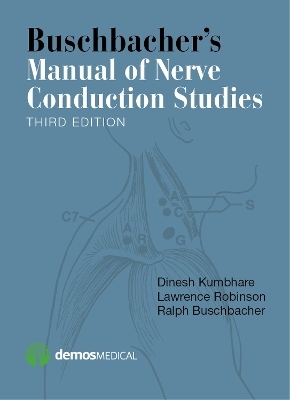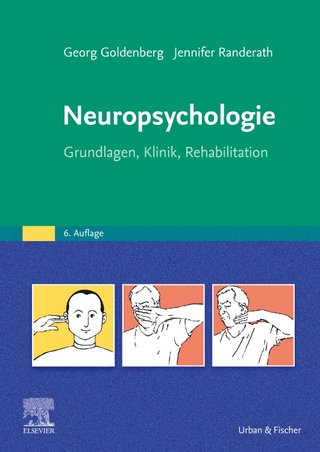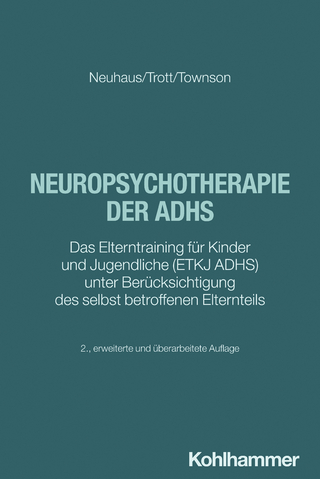
Buschbacher's Manual of Nerve Conduction Studies
Seiten
2015
|
3rd New edition
Demos Medical Publishing (Verlag)
978-1-62070-087-7 (ISBN)
Demos Medical Publishing (Verlag)
978-1-62070-087-7 (ISBN)
The gold standard in many EMG labs, this resource is a practical working reference for performing a wide variety of common nerve conduction studies. It provides both practicing clinicals and trainees with an impressive database of normal values they can use to interpret nerve conduction results with confidence. This third edition has been revised to deliver an up-to-date set of normal values.
The gold standard in many EMG labs, this resource is a practical working reference for performing a wide variety of common nerve conduction studies. It provides both practising clinicians and trainees with an impressive database of normal values they can use to interpret nerve conduction results with confidence. The third edition is revised to deliver an up-to-date set of normal values that take into account age, sex, height, and body mass index for a wide range of demographic groups. Two new authors bring a novel clinical perspective to the manual along with valuable tips and pearls to help the busy electromyographer conduct more effective studies and make a more informed diagnosis.
The third edition includes updated nomenclature and methodology for conducting nerve conduction tests along with supportive evidence to bolster all recommendations. New illustrations and diagrams supplement precise descriptions of electrode placements and study techniques. Additionally, the authors codify the acceptable differences in latency, amplitude, and nerve conduction velocity between nerves of the same or opposite limbs, to foster a more precise diagnosis. Recently updated references and suggested readings for each study provide the opportunity for more in-depth learning.
For determining normal reference values for any patient, or for review of a specific nerve conduction technique, this third edition of Buschbacher's Manual of Nerve Conduction Studies is essential for physicians and technologists alike.
Key Features:
New references, technique descriptions, and drawings bring the classic manual up to date.
Provides clinical pearls and tips for performing each study.
A new Appendix covers common anomalous innervations such as the Martin Gruber Anastomosis.
Offers a current, comprehensive set of reference values for clinical use.
Discusses advantages and pitfalls of alternative techniques.
Includes schematics to illustrate optimal electrode placement and typical waveform appearance.
The gold standard in many EMG labs, this resource is a practical working reference for performing a wide variety of common nerve conduction studies. It provides both practising clinicians and trainees with an impressive database of normal values they can use to interpret nerve conduction results with confidence. The third edition is revised to deliver an up-to-date set of normal values that take into account age, sex, height, and body mass index for a wide range of demographic groups. Two new authors bring a novel clinical perspective to the manual along with valuable tips and pearls to help the busy electromyographer conduct more effective studies and make a more informed diagnosis.
The third edition includes updated nomenclature and methodology for conducting nerve conduction tests along with supportive evidence to bolster all recommendations. New illustrations and diagrams supplement precise descriptions of electrode placements and study techniques. Additionally, the authors codify the acceptable differences in latency, amplitude, and nerve conduction velocity between nerves of the same or opposite limbs, to foster a more precise diagnosis. Recently updated references and suggested readings for each study provide the opportunity for more in-depth learning.
For determining normal reference values for any patient, or for review of a specific nerve conduction technique, this third edition of Buschbacher's Manual of Nerve Conduction Studies is essential for physicians and technologists alike.
Key Features:
New references, technique descriptions, and drawings bring the classic manual up to date.
Provides clinical pearls and tips for performing each study.
A new Appendix covers common anomalous innervations such as the Martin Gruber Anastomosis.
Offers a current, comprehensive set of reference values for clinical use.
Discusses advantages and pitfalls of alternative techniques.
Includes schematics to illustrate optimal electrode placement and typical waveform appearance.
Dinesh Kumbhare, MD, MSc, FRCPC, DABPMR, Associate Professor, Department of Medicine, University of Toronto, Canada and staff physician and affiliate scientist at the Toronto Rehabilitation Institute, Toronto, Canada. Lawrence Robinson, MD, Professor and Director, Division of Physiatry, Department of Medicine, University of Toronto, Canada and Chief, Rehabilitation Services, Sunnybrook Health Sciences Centre, Toronto, Canada. Ralph Buschbacher, MD, Professor, Department of Physical Medicine and Rehabilitation, Indiana University School of Medicine, Indianapolis, IN, USA.
| Erscheint lt. Verlag | 1.11.2015 |
|---|---|
| Zusatzinfo | 100 Illustrations |
| Verlagsort | New York, NY |
| Sprache | englisch |
| Maße | 152 x 229 mm |
| Themenwelt | Geisteswissenschaften ► Psychologie ► Biopsychologie / Neurowissenschaften |
| Medizin / Pharmazie ► Medizinische Fachgebiete ► Neurologie | |
| ISBN-10 | 1-62070-087-5 / 1620700875 |
| ISBN-13 | 978-1-62070-087-7 / 9781620700877 |
| Zustand | Neuware |
| Informationen gemäß Produktsicherheitsverordnung (GPSR) | |
| Haben Sie eine Frage zum Produkt? |
Mehr entdecken
aus dem Bereich
aus dem Bereich
Grundlagen, Klinik, Rehabilitation
Buch | Softcover (2024)
Urban & Fischer in Elsevier (Verlag)
CHF 78,40
Buch | Spiralbindung (2022)
modernes lernen (Verlag)
CHF 41,90
Das Elterntraining für Kinder und Jugendliche (ETKJ ADHS) unter …
Buch | Softcover (2024)
Kohlhammer (Verlag)
CHF 54,60


